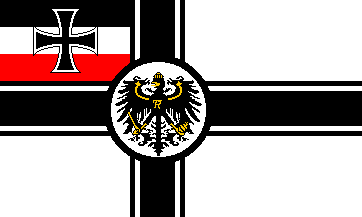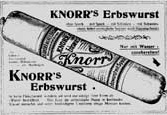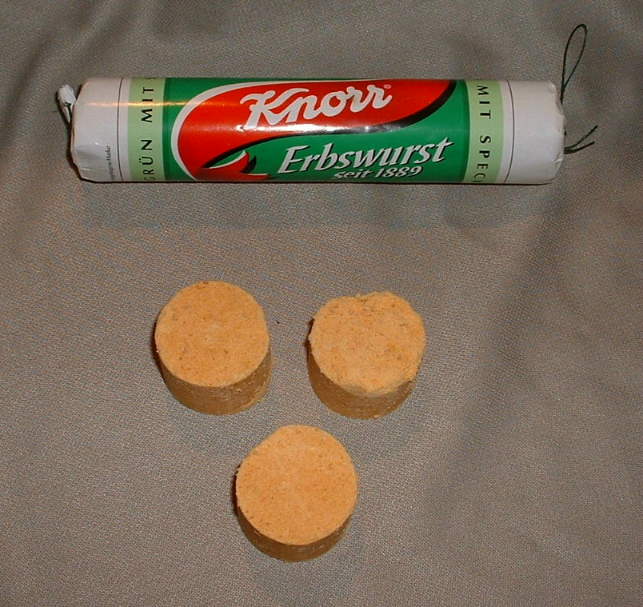|

German Rations 1870-1918
by Knackerstaff

Even though German had not been a truly united empire until 1871 after the victory of the German States against France,
German food trends were fairly straight-forward, and carried on into service rations.
The major portion of portable rations design stemmed from items issued to Prussian soldiers in the period just before the
Franco-Prussian war of 1870-71, in that it included slices of bacon, dried beans, hard bread, cheese, salt, sugar and small
amounts of coffee. Generally, these items were issued in regulated amounts, and just prior to engagements where field kitchen
rations may not be available. A standard carry-on ration per se did not exist, however.
With Prussias growth in military strength, and the perceived military threat from France, German planners realized that
with the added mobility of rail roads (upon which much of the German strategy in the coming war would rest), troops may well
operate outside a normal radius covered by supply trains. To this end, the Army research group of the Kingdom of Prussia set
out to look for a standard emergency/durable food item. In their search for the ideal food, they stumbled across a patent
for a compressed soup held by a factory owner in Berlin. The item is called Erbswurst, which loosely translates into Pea Sausage.
This name aptly describes the item! It is a foil or wax-paper lined sausage shaped roll which contains 6 tablets of compressed
split pea soup. This is made up of ground peas, bacon, spices and salt. Each of these tablets was intended to be mixed with
¼ liter (approx. 8 oz) of water and cooked for a short time to produce a nourishing soup. Along with these, Prussian troops
were issued with round biscuits (Hartkeks). These were only a marginal step up from hard tack, in that they could be chewed
with some effort without prior soaking. No other emergency or iron rations were standard issue, even though some meat tins
were held in reserve at rear trains to provide rations for special actions.
As an aside, one may wish to consider Prussian thoroughness when testing the suitability of this ration. One test concerning
the nutritional value of this ration consisted of providing some units only with Erbswurst, Bread and occasional fruit or
vegetables for six weeks on end!
| Erbswurst--Over 130 Years of German Army Service! |

|
1890s to 1914:
This remained a standard ration composition until 1888 when one of the imperial commissions in charge of equipment and
rations reviewed the existing supplies to soldiers. Even though the trusty Erbswurst and Hardbread combo had brought German
troops through the Franco-Prussian war, Germany's new global role demanded an improvement. With troops ranging from the Pacific,
the Arctic, Asia and remote outposts in Africa, individual rations more suited to prolonged consumption and soldiers tastes
had to be developed. Of course, standardization of such rations was an important factor.
Eventually, the commission made the following recommendation of what should be contained in a soldiers ration pack:
- Two 130 gram issues of Erbswurst
- Two 125 gram packs of Hard Bread
- 150 grams of Bacon
- Either 25 grams of Coffee or 3 grams of Tea
- One 25 gram pack of Sugar
- One 25 gram pack of Salt
This remained the standard issue ration throughout the end of the 19th into the early part of the 20th
Century. Additional rations were issued based on area of deployment.
For troops in the Pacific or Asia, for example, 125 grams of dried potatoes where made available, generally either in loose
issue, or, for expeditionary forces in the form of small waxed boxes, while troops in colder regions (such as assigned to
arctic researchers or on picket duty in Winter time), issues of chocolates or chocolate powder were made, along with higher
allowances for sugar in little waxed boxes.
Even though some hard candy and mints were issued throughout this time period, the troop demand for such 'childish candy'
was low, until the Boxer Rebellion in China.
Troops deployed in this action discovered ginger hard candy, and introduced this to their garrisons upon their return.
As with all fads, this went through the German armed forces like a wildfire, until very few German soldiers and sailors were
without a packet of ginger candy 'Ingwerbonbons'. Bavarian troops seemed to be the only ones immune to this fad; they retained
their fancy for "Malz" (Malt) candy, which is still available today.
|

